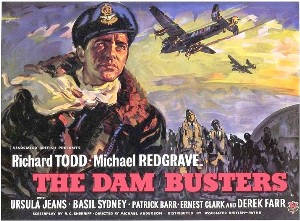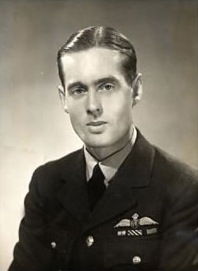
The Dam Busters is a 1955 British epic docudrama war film starring Richard Todd and Michael Redgrave, that was directed by Michael Anderson. Adapted by R. C. Sherriff from the books The Dam Busters (1951) by Paul Brickhill and Enemy Coast Ahead (1946) by Guy Gibson, the film depicts the true story of Operation Chastise when in 1943 the RAF's 617 Squadron attacked the Möhne, Eder, and Sorpe dams in Nazi Germany with Barnes Wallis's bouncing bomb.

Geoffrey Leonard Cheshire, Baron Cheshire, was a British Royal Air Force pilot, officer and philanthropist.

Operation Chastise, commonly known as the Dambusters Raid, was an attack on German dams carried out on the night of 16/17 May 1943 by 617 Squadron RAF Bomber Command, later called the Dam Busters, using special "bouncing bombs" developed by Barnes Wallis. The Möhne and Edersee dams were breached, causing catastrophic flooding of the Ruhr valley and of villages in the Eder valley; the Sorpe Dam sustained only minor damage. Two hydroelectric power stations were destroyed and several more damaged. Factories and mines were also damaged and destroyed. An estimated 1,600 civilians – about 600 Germans and 1,000 enslaved labourers, mainly Soviet – were killed by the flooding. Despite rapid repairs by the Germans, production did not return to normal until September. The RAF lost 56 aircrew, with 53 dead and 3 captured, amid losses of 8 aircraft.

Wing Commander Guy Penrose Gibson, was a distinguished bomber pilot in the Royal Air Force during the Second World War. He was the first Commanding Officer of No. 617 Squadron, which he led in the "Dam Busters" raid in 1943, resulting in the breaching of two large dams in the Ruhr area of Germany. He was awarded the Victoria Cross, the highest award for gallantry in the face of the enemy that can be awarded to British and Commonwealth forces, in the aftermath of the raid in May 1943 and became the most highly decorated British serviceman at that time. He completed over 170 war operations before being killed in action at the age of 26.

A bouncing bomb is a bomb designed to bounce to a target across water in a calculated manner to avoid obstacles such as torpedo nets, and to allow both the bomb's speed on arrival at the target and the timing of its detonation to be predetermined, in a similar fashion to a regular naval depth charge. The inventor of the first such bomb was the British engineer Barnes Wallis, whose "Upkeep" bouncing bomb was used in the RAF's Operation Chastise of May 1943 to bounce into German dams and explode underwater, with an effect similar to the underground detonation of the later Grand Slam and Tallboy earthquake bombs, both of which he also invented.

Number 617 Squadron is a Royal Air Force aircraft squadron, originally based at RAF Scampton in Lincolnshire and currently based at RAF Marham in Norfolk. It is commonly known as "The Dambusters", for its actions during Operation Chastise against German dams during the Second World War. In the early 21st century it operated the Panavia Tornado GR4 in the ground attack and reconnaissance role until being disbanded on 28 March 2014. The Dambusters reformed on 18 April 2018, and was equipped at RAF Marham in June 2018 with the Lockheed Martin F-35B Lightning, becoming the first squadron to be based in the UK with this advanced STOVL type. The unit is composed of both RAF and Royal Navy personnel, and operates from the Royal Navy's Queen Elizabeth-class aircraft carriers.

Tallboy or Bomb, Medium Capacity, 12,000 lb was an earthquake bomb developed by the British aeronautical engineer Barnes Wallis and used by the Royal Air Force (RAF) during the Second World War.
The Pathfinders were target-marking squadrons in RAF Bomber Command during World War II. They located and marked targets with flares, at which a main bomber force could aim, increasing the accuracy of their bombing. The Pathfinders were normally the first to receive new blind-bombing aids such as Gee, Oboe and the H2S radar.

The Bomb, Medium Capacity, 22,000 lb was a 22,000 lb (10,000 kg) earthquake bomb used by RAF Bomber Command against German targets towards the end of the Second World War. The bomb was originally called Tallboy Large until the term Tallboy got into the press and the code name was replaced by "Grand Slam". The bomb was similar to a large version of the Tallboy bomb but a new design and closer to the size that its inventor, Barnes Wallis, had envisaged when he developed the idea of an earthquake bomb. It was the largest and most powerful conventional aerial bomb used by either side during the war.

The Dortmund–Ems Canal is a 269-kilometre (167 mi) long canal in Germany between the inland port of the city of Dortmund and the seaport of Emden. The artificial southern part of the canal ends after 215 kilometres (134 mi) at Herbrum lock near Meppen. The route then takes the river Ems for 45 kilometres (28 mi) to Oldersum lock. From there, the canal continues along a second artificial segment of 9 kilometres (6 mi). This latter section was built because inland ships at the time of the construction of the canal were not built for the open sea, which they would have faced at the Dollart and the entry to the sea port of Emden. It is connected to the Ems-Jade Canal from Emden to Wilhelmshaven.

Royal Air Force Woodhall Spa, or more simply RAF Woodhall Spa, is a former Royal Air Force satellite station located 2 miles (3.2 km) north of Coningsby, Lincolnshire and 16 miles (26 km) southeast of Lincoln, Lincolnshire, England.

Operation Paravane was a British air raid of World War II that inflicted heavy damage on the German battleship Tirpitz, at anchor in Kaafjord in the far north of German-occupied Norway. The attack was conducted on 15 September 1944 by 21 Royal Air Force heavy bombers, which flew from an airfield in the north of the Soviet Union. The battleship was struck by one bomb, and further damaged by several near misses. This damage rendered Tirpitz unfit for combat, and she could not be repaired as it was no longer possible for the Germans to sail her to a major port.

Operation Obviate was an unsuccessful British air raid of World War II which targeted the German battleship Tirpitz. It was conducted by Royal Air Force heavy bombers on 29 October 1944, and sought to destroy the damaged battleship after she moved to a new anchorage near Tromsø in northern Norway.

Air Marshal Sir Harold Brownlow Morgan "Micky" Martin, was an Australian bomber pilot and senior commander in the Royal Air Force (RAF). He took part in Operation Chastise, the RAF's "Dambusters" raid in 1943, and was described by journalist Sir Max Hastings as "one of the three great bomber pilots of the war". He rose to become a senior officer in the RAF, commanding RAF Germany and later serving as Air Member for Personnel, a member of the Air Council, the RAF's controlling body.
Squadron Leader Henry Melvin "Dinghy" Young, was a bomber pilot in the Royal Air Force Volunteer Reserve during the Second World War.

Leslie Gordon Knight, was an Australian bomber pilot in the Royal Australian Air Force during the Second World War. He was awarded the Distinguished Service Order in 1943 for his role in Operation Chastise while flying with No. 617 Squadron RAF. Knight's crew, flying in N-Nan, attacked, hit and breached the Eder Dam, the second dam to be attacked, after his comrades had previously scored one hit and one miss.

David John Shannon, DSO & Bar, DFC & Bar was an Australian bomber pilot of World War II, known for his part in the "Dambusters" raid on the night of 16/17 May 1943. Born in South Australia, Shannon joined the Royal Australian Air Force (RAAF) in 1941 and learned to fly under the Empire Air Training Scheme. After further training in the United Kingdom he was posted to No. 106 Squadron RAF, operating Avro Lancaster heavy bombers, and was awarded the Distinguished Flying Cross (DFC) in January 1943.

Squadron Leader David John Hatfeild Maltby, was a bomber pilot in the Royal Air Force, best known for his part as the pilot of Lancaster AJ-J (“Johnny”) in the Dambusters raid. He had successfully completed over 30 operations before his death in September 1943.

Squadron Leader George Leonard Johnson, better known as Johnny Johnson, was a British Royal Air Force officer who was the last surviving original member of No. 617 Squadron RAF and of Operation Chastise, the "Dambusters" raid of 1943.
Sergeant Frederick Edwin Sutherland was one of the original members of No. 617 Squadron RAF, who participated in Operation Chastise and who at the time of his death had become the penultimate survivor of that raid. In addition he also participated in the later Operation Garlic during the course of which his aircraft sustained significant damage requiring him to bail out. He subsequently evaded capture and successfully returned to the United Kingdom.

















